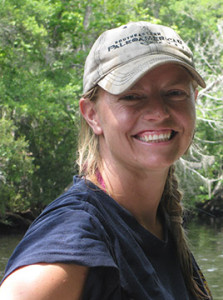Posted 8:19 a.m. Wednesday, Oct. 1, 2014

The story of how people first entered the Americas remains partly a mystery.
 The story of how people first entered the Americas remains partly a mystery. Jessi Halligan, assistant professor of UW-L Sociology/Archaeology, will present archaeological data that has challenged original theories of the peopling of the Americas and will discuss why scientists still do not know exactly what happened even after a century of research. Her free, public lecture will be at 7 p.m. Tuesday, Oct. 14, at Port O’ Call Cartwright Center-Gunning Addition.
For most of the twentieth century, scientists were sure they knew how and when the Americas were first colonized. They thought that the first people entered the New World during the last Ice Age — around 14,000 years ago — using the Bering Land Bridge that connected Asia to Alaska. They then followed mammoths and other big game into North America through an "ice-free corridor" between the enormous glaciers that covered most of Canada. Once they emerged south of the glaciers, they rapidly spread south and east to cover the entire continent by 13,000 years ago.
Over the past decade, new research has provided challenges to every portion of this narrative, indicating that the story of the peopling of the Americas is both much more complex and much more interesting than originally thought.
For more information call 608.785.6473 or email mvac@uwlax.edu.
If you go—
Who: Jessi Halligan, assistant professor of UW-L Sociology/Archaeology and MVAC research associate
What: ‘Exploring the Peopling of the Americas’
Where: Port O’ Call, Cartwright Center-Gunning Addition
When: 7 p.m. Tuesday, Oct. 14
Admission: Free
The story of how people first entered the Americas remains partly a mystery. Jessi Halligan, assistant professor of UW-L Sociology/Archaeology, will present archaeological data that has challenged original theories of the peopling of the Americas and will discuss why scientists still do not know exactly what happened even after a century of research. Her free, public lecture will be at 7 p.m. Tuesday, Oct. 14, at Port O’ Call Cartwright Center-Gunning Addition.
For most of the twentieth century, scientists were sure they knew how and when the Americas were first colonized. They thought that the first people entered the New World during the last Ice Age — around 14,000 years ago — using the Bering Land Bridge that connected Asia to Alaska. They then followed mammoths and other big game into North America through an "ice-free corridor" between the enormous glaciers that covered most of Canada. Once they emerged south of the glaciers, they rapidly spread south and east to cover the entire continent by 13,000 years ago.
Over the past decade, new research has provided challenges to every portion of this narrative, indicating that the story of the peopling of the Americas is both much more complex and much more interesting than originally thought.
For more information call 608.785.6473 or email mvac@uwlax.edu.
If you go—
Who: Jessi Halligan, assistant professor of UW-L Sociology/Archaeology and MVAC research associate
What: ‘Exploring the Peopling of the Americas’
Where: Port O’ Call, Cartwright Center-Gunning Addition
When: 7 p.m. Tuesday, Oct. 14
Admission: Free